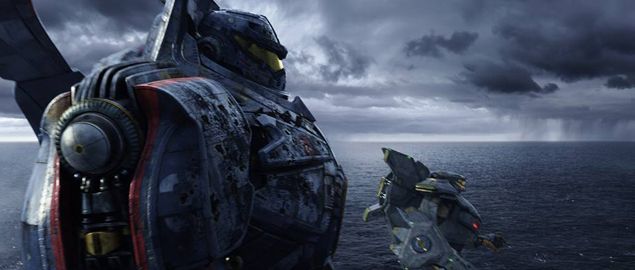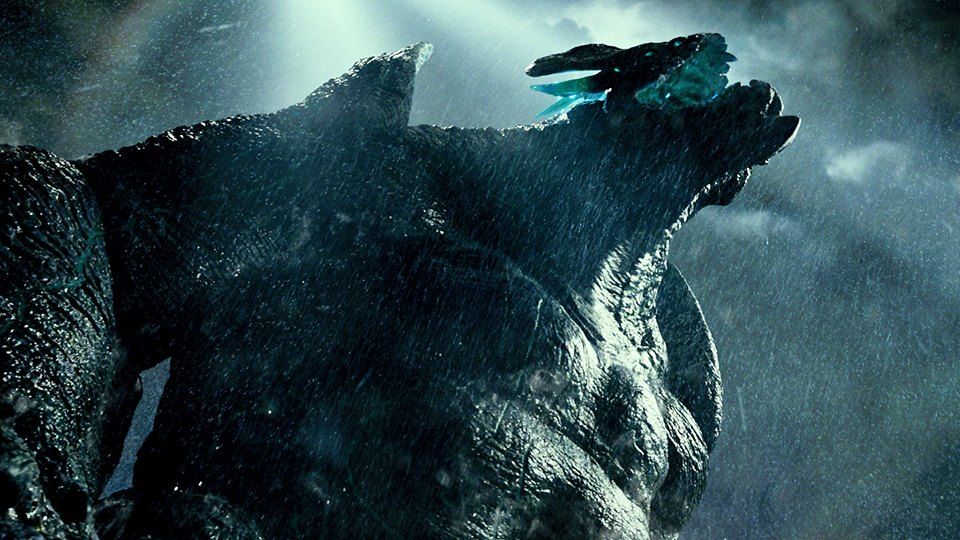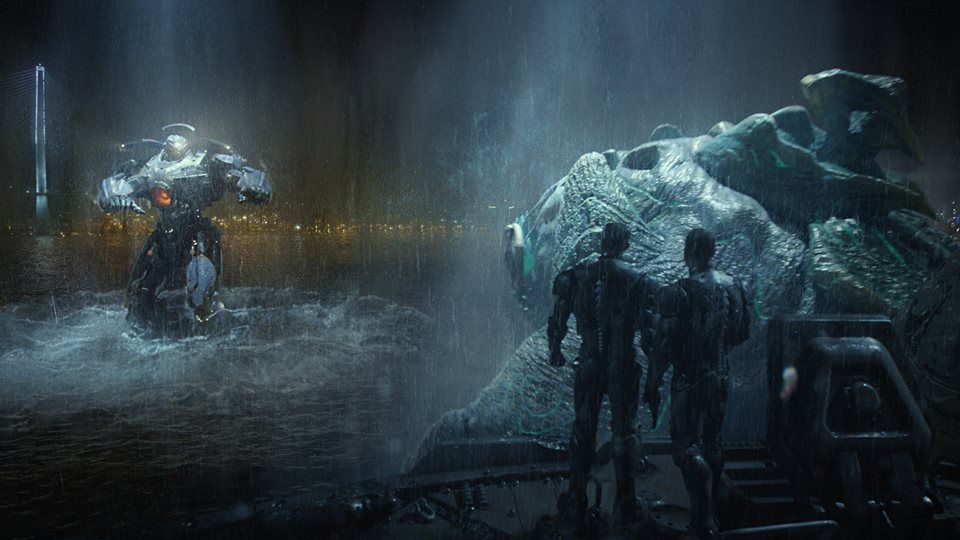Guillermo del Toro destroys the world and dominates the summer blockbuster season with Pacific Rim. It's his first directorial effort since 2008's Hellboy II: The Golden Army, if you can believe it. Believe this, too: Pacific Rim is large and in charge, a massive and monstrous movie about massive monsters, and the humans who become giants to fight them back.
Pacific Rim begins in the present day, at the start of the apocalypse. Impossibly sized creatures called Kaiju have breached our world through an inter-dimensional rift in the Pacific Ocean, leveling many of Earth's greatest cities. The people of the world respond by abandoning their petty differences to create weapons that can counter the Kaiju threat: Jaegers, giant robots controlled by two human pilots who sync up through a neural bridge called The Drift and work in unison to keep the world safe, one dead Kaiju at a time.
The Jaeger program successfully curbs the Kaiju threat — for a time. As years wear on, the Kaijus become more resilient against the Jaegers, destroying the mech-suits faster than man can build them. The global powers that be decide to close the program, refocusing their efforts on building great walls to keep Kaijus at bay. But even the walls are failing. With mankind on its knees, and with the Jaeger program weeks away from permanent shutdown, Marshal Stacker Pentecost (Idris Elba) devises a desperate and drastic plan to squash the Kaiju threat once and for all — but to make it happen, he needs a retired Jaeger jockey named Raleigh Beckett (Charlie Hunnam) to rejoin the cause.
In Pacific Rim, del Toro has created a universe fitting of its huge combatants. The details are many and precise, from the varying categories of Kaijus and Jaegers all the way down to the criminal black market for Kaiju leftovers. The world is dirty and dangerous, worn-in and true. And it's not a world that's hard to grasp, either, despite the high concepts at play. Del Toro and co-writer Travis Beachem introduce Pacific Rim in easily digestible bites, beginning with a title card featuring definitions of the words "Kaiju" and "Jaeger," and continuing with Raleigh's detailed but relatable opening monologue about how and why the world went to hell. It takes little time at all for Pacific Rim to feel like home.
With a rich world comes rich characters. Every player in Pacific Rim has a story to tell, from Clifton Collins Jr. as sharp-looking Jaeger technician Tendo Choi to the scenery-chewing Ron Perlman as Kaiju-parts dealer Hannibal Chau. No man or woman is too small for a healthy helping of backstory, even if it's as simple as a look between father-son pilot duo Herc and Chuck Hansen, or something as blood-deep as a crucial character's recurring nosebleeds. Everyone has a story to tell, and all of them are worth following.
As Raleigh, Charlie Hunnam shoulders most of the story's weight, or at least most of its screen time. Hunnam is best known for his starring role on FX's Sons of Anarchy, and he plays a similar character here: a man who gets the job done, because the job needs to get done. It's Jax Teller sans bike and illegal dealings, plus Kaiju-killing mech-suit and world-ending stakes. It works.
Less effective is Raleigh's relationship with Mako Mori, a rookie pilot who lost her family in a Kaiju attack. Not because actress Rinko Kikuchi doesn't deliver the goods, but because the story isn't clear on the relationship between the two. Are they lovers? Are they friends? Del Toro wants to have his cake and eat it too, presenting them as a possible romantic couple, but leaving it ambiguous enough that they might just be colleagues with great chemistry. It's a rare bit of indecision that hurts the movie, but not to a crippling degree.
The Raleigh-Mako dynamic is one of Pacific Rim's few weaknesses. On her own, however, Mako is a compelling character; indeed, she's at the heart of the film's strongest sequence -- a flashback to the Kaiju attack that claimed her family many years earlier. Child actress Mana Ashida brings Mako to stunning life for the scene, delivering the most gripping performance in the entire movie, and providing the best example of how inescapably huge Pacific Rim really is.
Make no mistake: Size and scope are the bread and butter of Pacific Rim. It's a movie that demands to be seen on the big screen because of its sheer scale. Every shot of a human standing in the vicinity of a Jaeger or a Kaiju is absolutely breathtaking. Watching these gargantuan gladiators rip each other to shreds in the middle of the world's greatest cities, in the depths of the ocean, is a literally stunning experience. I lost track of how many times my jaw dropped or my arms shot up in the air just by virtue of how huge everything is — and yet, despite the size, everything is so carefully crafted: from the actual details of how the Jaegers and Kaijus function, to the choreography and arcs of the action scenes.
Pacific Rim is a destructive force, quite possibly the loudest voice in the room as far as the summer movie season is concerned — and that's saying something. Reactions to the carnage and mayhem on display in films like Star Trek Into Darkness and especially Man of Steel have varied, with many fans outraged at the reckless on-screen violence that leaves thousands of innocents dead and forgotten. There's no question that Pacific Rim adds to that body count. Even as a Jaeger swoops in to save a city from certain destruction, it does so while smashing into buildings and stomping on car-filled streets. One can only imagine the death toll.
But that's in line with the climate of Pacific Rim. It's a world where all is lost, or damn close to it. Cities are falling, the population is dropping, and the frequency of Kaiju attacks is on the rise, with few solutions emerging. A bitter old man once said, "Desperation is a stinky cologne." Everyone living in the world of Pacific Rim is wearing it, and so the question becomes: When extinction is not just a possibility but an expectation and inevitability, what choices are left?
Del Toro's answer is on the screen, and in the film's tagline: Go big, or go extinct. Pacific Rim chooses the former. As a result, it leaves a formidable footprint on the catastrophe conversation so many fans and critics alike have engaged in this summer. If that conversation is important to you, you owe it to yourself to see Pacific Rim.
At the same time, if you just want to see giant robots fight giant monsters while Idris Elba barks orders like a badass, you should probably see it, too.
Pacific Rim invades theaters on Friday.



